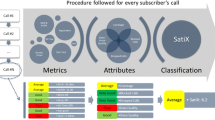Abstract
Future mobile networks will be increasingly heterogeneous. Already today, wireless LAN is used by many mobile network operators as an addition to traditional technologies like GSM and UMTS; WiMax and 3GPP Long Term Evolution (LTE) will be added. Having heterogeneous wireless networks, one challenging research question needs to be answered: Which user should be served by which access network and when to conduct a handover? For such decisions, information on the state of networks and terminals is required. In this publication, we simulate mobile networks in which a central entity called Network Resource Management (N-RM) gives handover recommendations to mobile terminals. Based on these recommendations and local knowledge on link qualities, the terminals choose the cell to switch to. The N-RM should have a global view on the networks to give best recommendations. We designed the Generic Metering Infrastructure (GMI), a publish/subscribe system to collect information about access networks and terminals efficiently.
We investigate the tradeoff between the signalling overhead caused by data collection and the quality of the handover decisions and show, how smart monitoring can reduce the amount of measurement data while ensuring the efficient use of heterogeneous networks. In addition, our simulation results show that combined local and central handover decisions significantly increase the capacity of the networks as compared to only local decisions.
Similar content being viewed by others
References
IEEE802.16 (2004). Air Interface for Fixed Broadband Wireless Access Systems. IEEE Standard for Local and Metropolitan Area Networks, Oct. 2004.
3GPP (2008). TS 23.401 v8.4.1: General Packet Radio Service (GPRS) enhancements for Evolved Universal Terrestrial Radio Access Network (E-UTRAN) access.
3GPP (2008). TS 23.402 v8.4.1: Architecture enhancements for non-3GPP accesses.
Wang, H. J., Katz, R. H., & Giese, J. (1999). Policy-enabled handoffs across heterogeneous wireless networks. In WMCSA ’99: proceedings of the second IEEE workshop on mobile computer systems and applications (p. 51). Washington: IEEE Computer Society.
Monger, A., Fouquet, M., Hoene, C., Carle, G., & Schläger, M. (2009). A metering infrastructure for heterogeneous mobile networks. In First international conference on COMmunication systems and NETworkS (COMSNETS), Bangalore, India, Jan. 2009.
Fan, C., Schläger, M., Udugama, A., Pangboonyanon, V., Toker, A. C., & Coskun, G. (2007). Managing heterogeneous access networks. Coordinated policy based decision engines for mobility management. In LCN ’07: proceedings of the 32nd IEEE conference on local computer networks (pp. 651–660). Washington: IEEE Computer Society.
3GPP (2008). TS 32.401 V8.0.0: Telecommunication management; Performance Management (PM); Concept and requirements (Release 8).
Martin, B., & Jano, B. (1999). WAP Binary XML Content Format. http://www.w3.org/TR/wbxml/.
Google Inc. (2008). Protocol Buffers. http://code.google.com/apis/protocolbuffers/.
Calhoun, P., Loughney, J., Guttman, E., Zorn, G., & Arkko, J. (2003). Diameter Base Protocol. RFC 3588 (Proposed Standard), Sept. 2003. [Online]. Available: http://www.ietf.org/rfc/rfc3588.txt.
Claise, B. (2008). Specification of the IP Flow Information Export (IPFIX) Protocol for the Exchange of IP Traffic Flow Information. RFC 5101 (Proposed Standard), Jan. 2008. [Online]. Available: http://www.ietf.org/rfc/rfc5101.txt.
Ziv, J., & Lempel, A. (1977). A universal algorithm for sequential data compression. IEEE Transactions on Information Theory, 23, 337–343.
Gazis, V., Alonistioti, N., & Merakos, L. (2005). Toward a generic “always best connected” capability in integrated WLAN/UMTS cellular mobile networks (and beyond). Wireless Communications, IEEE, 12, 20–29.
Stevens-Navarro, E., & Wong, V. (2006). Comparison between vertical handoff decision algorithms for heterogeneous wireless networks. In Vehicular technology conference, 2006. VTC 2006-Spring. IEEE 63rd (Vol. 2, pp. 947–951), May 2006.
Pries, R., Mäder, A., & Staehle, D. (2006). A network architecture for a policy-based handover across heterogeneous networks. In OPNETWORK 2006, Washington DC, USA, Aug. 2006.
Tölli, A., & Hakalin, P. (2002). Adaptive load balancing between multiple cell layers. In Vehicular technology conference, 2002. Proceedings. VTC 2002-Fall. 2002 IEEE 56th (Vol. 3, pp. 1691–1695).
IEEE802.21 (2007). Media Independent Handover Services. http://www.ieee802.org/21/.
Author information
Authors and Affiliations
Corresponding author
Rights and permissions
About this article
Cite this article
Fouquet, M., Hoene, C., Schläger, M. et al. Data collection in future mobile networks. Telecommun Syst 48, 289–300 (2011). https://doi.org/10.1007/s11235-010-9344-9
Published:
Issue Date:
DOI: https://doi.org/10.1007/s11235-010-9344-9




